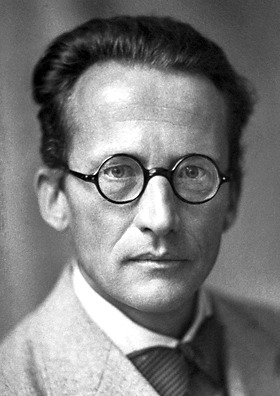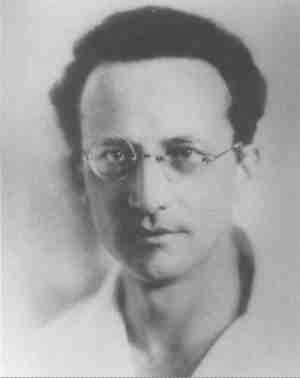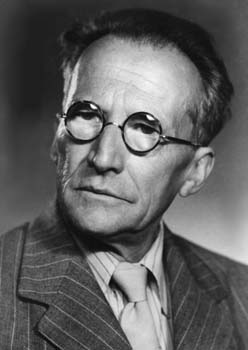<Back to Index>
- Physicist Erwin Rudolf Josef Alexander
Schrödinger, 1887
PAGE SPONSOR



Erwin Rudolf Josef Alexander Schrödinger (12 August 1887 – 4 January 1961), was an Austrian physicist who developed a number of fundamental results in the field of quantum theory, which formed the basis of wave mechanics: he formulated the wave equation (stationary and time - dependent Schrödinger equation) and revealed the identity of his development of the formalism and matrix mechanics. Schrödinger proposed an original interpretation of the physical meaning of the wave function and in subsequent years repeatedly criticized the conventional Copenhagen interpretation of quantum mechanics (using, e.g., the paradox of Schrödinger's cat). In addition, he is the author of many works in various fields of physics: statistical mechanics and thermodynamics, physics of dielectrics, color theory, electrodynamics, general relativity and cosmology, and he made several attempts to construct a unified field theory. In his book "What is life?" Schrödinger addressed the problems of genetics, looking at the phenomenon of life from the point of view of physics. He paid great attention to the philosophical aspects of science, ancient and oriental philosophical concepts, ethics and religion. He also wrote on philosophy and theoretical biology.
In 1887 Schrödinger was born in Vienna, Austria to Rudolf Schrödinger (cerecloth producer, botanist) and Georgine Emilia Brenda (daughter of Alexander Bauer, Professor of Chemistry, Technische Hochschule Vienna). He was their only child.
His mother was half Austrian and half English; his father was Catholic and his mother was Lutheran. Despite having a religious background, he later on became an atheist.
Schrödinger graduated from the Akademisches Gymnasium in 1906 and, in that year, entered the University of Vienna. In theoretical physics he studied analytical mechanics, applications of partial differential equations to dynamics, eigenvalue problems, Maxwell's equations and electromagnetic theory, optics, thermodynamics and statistical mechanics. It was Fritz Hasenöhrl's lectures on theoretical physics which had the greatest influence on Schrödinger. In mathematics he was taught calculus and algebra by Franz Mertens, function theory, differential equations and mathematical statistics by Wilhelm Wirtinger (whom he found uninspiring as a lecturer). He also studied projective geometry, algebraic curves and continuous groups in lectures given by Gustav Kohn.
On 20 May 1910, Schrödinger was awarded his doctorate for the dissertation On the conduction of electricity on the surface of insulators in moist air. After this he undertook voluntary military service in the fortress artillery. Then he was appointed to an assistantship at Vienna but, rather surprisingly, in experimental physics rather than theoretical physics. He later said that his experiences conducting experiments proved an invaluable asset to his theoretical work since it gave him a practical philosophical framework in which to set his theoretical ideas.
He was also able to learn English outside of school, as his maternal grandmother was British. Between 1906 and 1910 Schrödinger studied in Vienna under Franz Serafin Exner (1849 – 1926) and Friedrich Hasenöhrl (1874 – 1915). He also conducted experimental work with Karl Wilhelm Friedrich "Fritz" Kohlrausch.
In 1911 Schrödinger became an assistant to Exner. At an early age, Schrödinger was strongly influenced by Arthur Schopenhauer. As a result of his extensive reading of Schopenhauer's works, he became deeply interested throughout his life in color theory and philosophy. In his lecture "Mind and Matter," he said that "the world extended in space and time is but our representation." This is a repetition of the first words of Schopenhauer's main work.
In 1914 Erwin Schrödinger achieved Habilitation (venia legendi). Between 1914 and 1918 he participated in war work as a commissioned officer in the Austrian fortress artillery (Gorizia, Duino, Sistiana, Prosecco, Vienna). On 6 April 1920, Schrödinger married Annemarie Bertel in 1919 and Anny had come to work as a secretary in Vienna on a monthly salary which was more than Schrödinger's annual income. Then he was offered an associate professorship, still not at a salary large enough to support a non - working wife, so he declined. The same year, he became the assistant to Max Wien, in Jena, and in September 1920 he attained the position of ao. Prof. (Ausserordentlicher Professor), roughly equivalent to Reader (UK) or associate professor (US), in Stuttgart. In 1921, he became o. Prof. (Ordentlicher Professor, i.e., full professor), in Breslau (now Wrocław, Poland). Schrödinger had worked at Vienna on radioactivity, proving the statistical nature of radioactive decay. He had also made important contributions to the kinetic theory of solids, studying the dynamics of crystal lattices. On the strength of his work he was offered an associate professorship at Vienna in January 1920.
In 1921, he moved to the University of Zürich. In 1927, he succeeded Max Planck at the Friedrich Wilhelm University in Berlin. In 1933, however, Schrödinger decided to leave Germany; he disliked the Nazis' antisemitism. He became a Fellow of Magdalen College at the University of Oxford. Soon after he arrived, he received the Nobel Prize together with Paul Dirac. His position at Oxford did not work out; his unconventional personal life (Schrödinger lived with two women) was not met with acceptance. In 1934, Schrödinger lectured at Princeton University; he was offered a permanent position there, but did not accept it. Again, his wish to set up house with his wife and his mistress may have posed a problem. He had the prospect of a position at the University of Edinburgh but visa delays occurred, and in the end he took up a position at the University of Graz in Austria in 1936.
In the midst of these tenure issues in 1935, after extensive correspondence with Albert Einstein, he proposed what is now called the Schrödinger's cat thought experiment.
In 1939, after the Anschluss, Schrödinger had problems because of his flight from Germany in 1933 and his known opposition to Nazism. He issued a statement recanting this opposition (he later regretted doing so and personally apologized to Einstein). However, this did not fully appease the new dispensation and the university dismissed him from his job for political unreliability. He suffered harassment and received instructions not to leave the country, but he and his wife fled to Italy. From there, he went to visiting positions in Oxford and Ghent Universities.
In 1940, he received a personal invitation from Ireland's Taoiseach, Éamon de Valera, to reside in Ireland and agree to help establish an Institute for Advanced Studies in Dublin. He moved to Clontarf, Dublin and became the Director of the School for Theoretical Physics and remained there for 17 years. He became a naturalized Irish citizen in 1948, but retained his Austrian citizenship. He wrote about 50 further publications on various topics, including his explorations of unified field theory.
In 1944, he wrote What is Life?, which contains a discussion of negentropy and the concept of a complex molecule with the genetic code for living organisms. According to James D. Watson's memoir, DNA, the Secret of Life, Schrödinger's book gave Watson the inspiration to research the gene, which led to the discovery of the DNA double helix structure in 1953. Similarly, Francis Crick, in his autobiographical book What Mad Pursuit, described how he was influenced by Schrödinger's speculations about how genetic information might be stored in molecules. However, the geneticist and 1946 Nobel prize winner H.J. Muller had in his 1922 article "Variation due to Change in the Individual Gene" already laid out all the basic properties of the heredity molecule that Schrödinger derives from first principles in What is Life?, properties which Muller refined in his 1929 article "The Gene As The Basis of Life" and further clarified during the 1930s, long before the publication of What is Life?.
Schrödinger stayed in Dublin until retiring in 1955. During this time he remained committed to his particular passion; involvements with students occurred and he fathered two children by two different Irish women. He had a lifelong interest in the Vedanta philosophy of Hinduism, which influenced his speculations at the close of What is Life? about the possibility that individual consciousness is only a manifestation of a unitary consciousness pervading the universe. A manuscript "Fragment From An Unpublished Dialogue of Galileo" from this time recently resurfaced at The King's Hospital boarding school, Dublin after it was written for the School's 1955 edition of their Blue Coat to celebrate his leaving of Dublin to take up his appointment as Chair of Physics at the University of Vienna.
In 1956, he returned to Vienna (chair ad personam). At an important lecture during the World Energy Conference he refused to speak on nuclear energy because of his skepticism about it and gave a philosophical lecture instead. During this period Schrödinger turned from mainstream quantum mechanics' definition of wave – particle duality and promoted the wave idea alone, causing much controversy.
Schrödinger suffered from tuberculosis and several times in the 1920s stayed at a sanatorium in Arosa. It was there that he discovered his wave equation.
Schrödinger decided in 1933 that he could not live in a country in which persecution of Jews had become a national policy. Alexander Frederick Lindemann, the head of physics at Oxford University, visited Germany in the spring of 1933 to try to arrange positions in England for some young Jewish scientists from Germany. He spoke to Schrödinger about posts for one of his assistants and was surprised to discover that Schrödinger himself was interested in leaving Germany. Schrödinger asked for a colleague, Arthur March, to be offered a post as his assistant.
The request for March stemmed from Schrödinger's unconventional relationships with women: although his relations with his wife Anny were good, he had had many lovers with his wife's full knowledge (and in fact, Anny had her own lover, Hermann Weyl). Schrödinger asked for March to be his assistant because, at that time, he was in love with March's wife Hilde.
Many of the scientists who had left Germany spent mid 1933 in the Italian province of South Tyrol. Here Hilde became pregnant with Schrödinger's child. On 4 November 1933 Schrödinger, his wife and Hilde March arrived in Oxford. Schrödinger had been elected a fellow of Magdalen College. Soon after they arrived in Oxford, Schrödinger heard that, for his work on wave mechanics, he had been awarded the Nobel prize.
In early 1934 Schrödinger was invited to lecture at Princeton University and while there he was made an offer of a permanent position. On his return to Oxford he negotiated about salary and pension conditions at Princeton but in the end he did not accept. It is thought that the fact that he wished to live at Princeton with Anny and Hilde both sharing the upbringing of his child was not found acceptable. The fact that Schrödinger openly had two wives, even if one of them was married to another man, was not well received in Oxford either. His daughter Ruth Georgie Erica was born there on 30 May 1934.
On 4 January 1961, Schrödinger died in Vienna at the age of 73 of tuberculosis. He left a widow, Anny (born Annemarie Bertel on 3 December 1896, died 3 October 1965), and was buried in Alpbach, Austria.
Early in his life, Schrödinger was heavily involved in experiments relating to electrical engineering, atmospheric electricity and atmospheric radioactivity, usually with his then teacher Franz Exner. He also studied vibrational theory, the theory of Brownian movement and mathematical statistics. In 1912, at the request of the editors of the Handbook of Electricity and Magnetism, Schrodinger wrote an article titled Dieelectrism. That same year, Schrödinger gave a theoretical estimate of the probable height distribution of radioactive substances, which is required to explain the observed radioactivity of the atmosphere, and in August 1913 executed several experiments in Zeehame that confirmed his theoretical estimate and those of Victor Franz Hess. For this work, Schrödinger was awarded the 1920 Haytingera Prize (Haitinger - Preis) of the Austrian Academy of Sciences. Other experimental studies conducted by the young researcher in 1914 were checking formulas for capillary pressure in gas bubbles and the study of the properties of soft beta radiation appearing in the fall of gamma rays on the surface of metal. The last work he performed together with his friend Fritz Kohlrausch. In 1919, Schrödinger performed his last physical experiment on coherent light and subsequently focused on theoretical studies.
In the first years of his career Schrödinger became acquainted with the ideas of quantum theory, developed in the works of Max Planck, Albert Einstein, Niels Bohr, Arnold Sommerfeld, and others. This knowledge helped him work on some problems in statistical physics, but the Austrian scientist at the time was not yet ready to part with the traditional methods of classical physics.
The first publications of Schrödinger about atomic theory and the theory of spectra began to emerge only from the beginning of the 1920s, after his personal acquaintance with Sommerfeld and Wolfgang Pauli and his move to Germany. In January 1921, Schrödinger finished his first article on this subject, about the framework of the Bohr - Sommerfeld effect of the interaction of electrons on some features of the spectra of the alkali metals. Of particular interest to him was the introduction of relativistic considerations in quantum theory. In autumn 1922 he analyzed the electron orbits in an atom from a geometric point of view, using methods developed by the mathematician Hermann Weyl. This work, in which it was shown that quantum orbits can be associated with certain geometric properties, was an important step in predicting some of the features of wave mechanics. Earlier in the same year he created the Schrödinger equation of the relativistic Doppler effect for spectral lines, based on the hypothesis of light quanta and considerations of energy and momentum. He liked the idea of his teacher Exner on the statistical nature of the conservation laws, so he enthusiastically embraced the articles of Bohr, Kramers and Slater, which suggested the possibility of violation of these laws in individual atomic processes (for example, in the process of emission of radiation). Despite the fact that the experiments of Hans Geiger and Walther Bothe soon cast doubt on this, the idea of energy as a statistical concept was a lifelong attraction for Schrödinger and he discussed it in some reports and publications.
In January 1926, Schrödinger published in Annalen der Physik the paper "Quantisierung als Eigenwertproblem" [tr. Quantization as an Eigenvalue Problem] on wave mechanics and presented what is now known as the Schrödinger equation. In this paper he gave a "derivation" of the wave equation for time independent systems, and showed that it gave the correct energy eigenvalues for a hydrogen - like atom. This paper has been universally celebrated as one of the most important achievements of the twentieth century, and created a revolution in quantum mechanics and indeed of all physics and chemistry. A second paper was submitted just four weeks later that solved the quantum harmonic oscillator, the rigid rotor and the diatomic molecule, and gave a new derivation of the Schrödinger equation. A third paper in May showed the equivalence of his approach to that of Heisenberg and gave the treatment of the Stark effect. A fourth paper in this most remarkable series showed how to treat problems in which the system changes with time, as in scattering problems. These papers were the central achievement of his career and were at once recognized as having great significance by the physics community.
The philosophical issues raised by Schrödinger's cat are still debated today and remains his most enduring legacy in popular science, while Schrödinger's equation is his most enduring legacy at a more technical level. The huge crater Schrödinger, on the far side of the Moon, is named after him. The Erwin Schrödinger International Institute for Mathematical Physics was established in Vienna in 1993.
One of Schrödinger's lesser known areas of scientific contribution was his work on color, color perception, and colorimetry (Farbenmetrik). In 1920, he published three papers in this area:
- "Theorie der Pigmente von größter Leuchtkraft," Annalen der Physik, (4), 62, (1920), 603–22
- "Grundlinien einer Theorie der Farbenmetrik im Tagessehen," Annalen der Physik, (4), 63, (1920), 397–456; 481–520 (Outline of a theory of color measurement for daylight vision)
- "Farbenmetrik," Zeitschrift für Physik, 1, (1920), 459–66 (Color measurement).